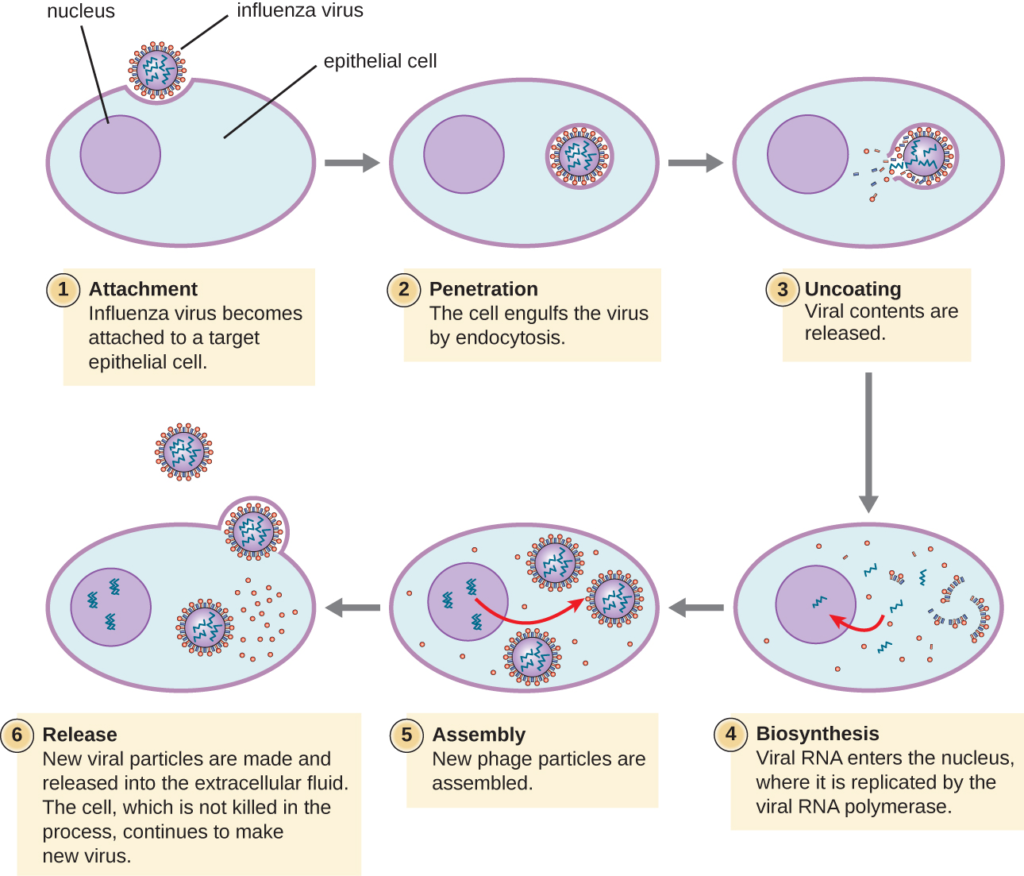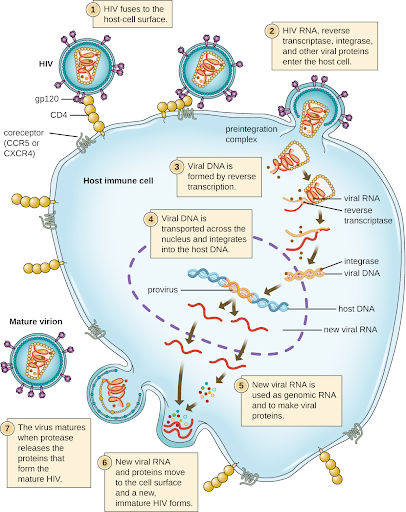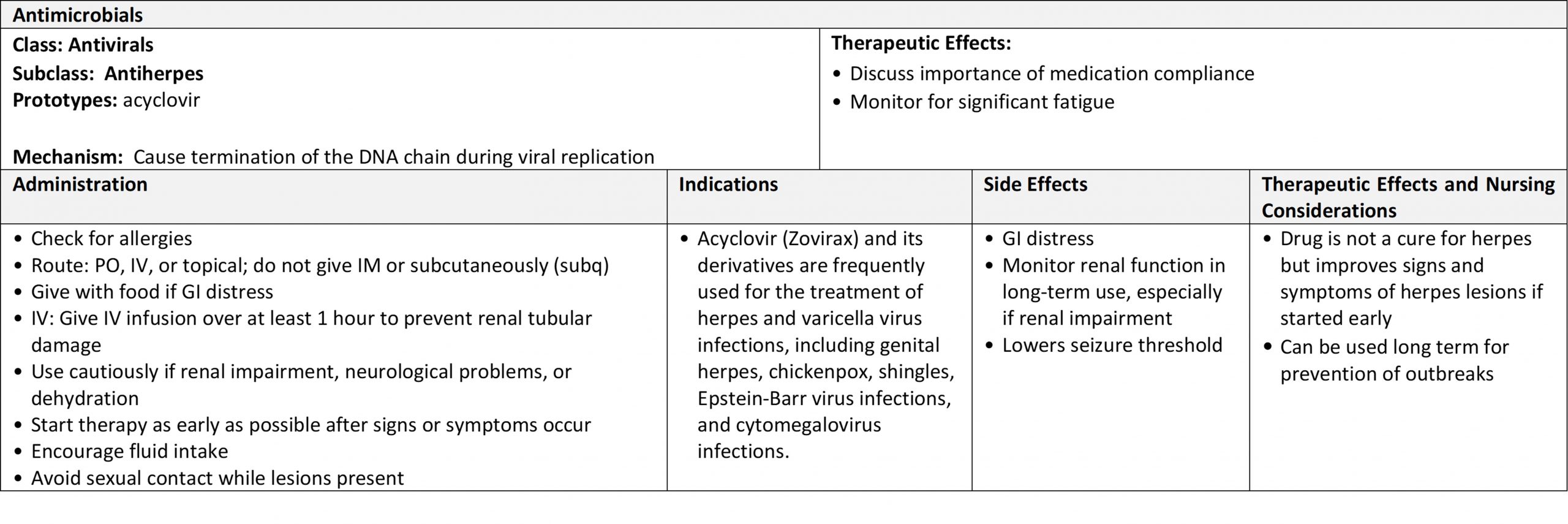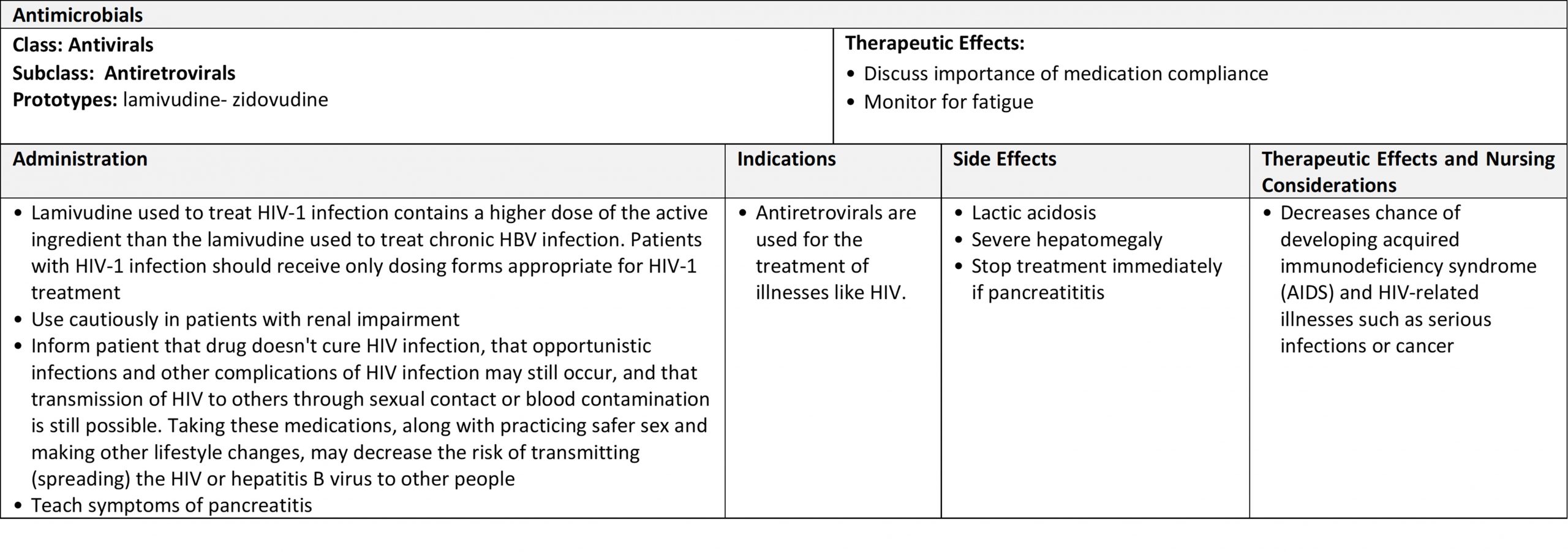Antimicrobials
3.15 Antivirals
Open Resources for Nursing (Open RN)

Unlike the complex structure of fungi or protozoa, viral structure is simple. There are several subclasses of antiviral medications: antiherpes, antiinfluenza, anti-hepatitis, and antiretrovirals. Each subclass will be discussed in more detail below. See Figure 3.10[1] for images of viruses.
Subclass: Antiherpes
Indications for Use: Acyclovir (Zovirax) and its derivatives are frequently used for the treatment of herpes and varicella virus infections, including genital herpes, chickenpox, shingles, Epstein-Barr virus infections, and cytomegalovirus infections.
Mechanism of Action: Acyclovir causes termination of the DNA chain during the viral replication process. Acyclovir can be administered either topically or systemically, depending on the infection.[2]
Special Administration Considerations: Acyclovir use may result in nephrotoxicity.
Client Teaching & Education: Clients who are being treated with antiviral therapy should be instructed about the importance of medication compliance. They may also experience significant fatigue, so periods of rest should be encouraged.[3]
Subclass: AntiInfluenza
Indications for Use: Tamiflu (oseltamivir) is used to target the influenza virus by blocking the release of the virus from the infected cells.
Mechanism of Action: Tamiflu prevents the release of virus from infected cells.
Special Administration Considerations: This medication does not cure influenza, but can decrease flu symptoms and shorten the duration of illness if taken in a timely manner. Ckients are prescribed the medication for prophylaxis against infection, known exposure, or to lesson the course of the illness. If clients experience flu-like symptoms, it is critical that they start treatment within 48 hours of symptom onset.
Client Teaching & Education: Clients who are being treated with antiviral therapy should be instructed about the importance of medication compliance. They may also experience significant fatigue, so periods of rest should be encouraged.[4]
The influenza virus is one of the few RNA viruses that replicates in the nucleus of cells. Antivirals block the release stage. See Figure 3.11.[5]

Subclass: Antiretrovirals
Viruses with complex life cycles, such as HIV, can be more difficult to treat. These types of viruses require the use of antiretroviral medications that block viral replication. (See Figure 3.12 to view the viral replication process of HIV.) [6] Additionally, antiretrovirals fall under the class of antiviral medications.

Indications for Use: Antiretrovirals are used for the treatment of illnesses like HIV.
Mechanism of Action: Antiretrovirals impede virus replication.
Special Administration Considerations: Many antiretrovirals may impact renal function; therefore, the client’s urine output and renal labs should be monitored carefully for signs of decreased function.
Client Teaching & Education: Clients who are being treated with antiviral therapy should be instructed about the importance of antiretroviral compliance. They may also experience significant fatigue, so periods of rest should be encouraged.[7]
Now let’s take a closer look at the medication cards for the subclasses of antivirals in Table 3.14a-d.[8][9][10][11][12] Because information about medication is constantly changing, nurses should always consult evidence-based resources to review current recommendations before administering specific medication.
Tables 3.14a Acyclovir Medication Card
Class/Subclass: Antivirals/Antiherpes (prototype: acyclovir)

Tables 3.14b Oseltamivir Medication Card
Class/Subclass: Antivirals/Anti-Influenza Agents (prototype: oseltamivir)

Tables 3.14c Adefovir Medication Card
Class/Subclass: Antivirals/Anti-Hepatitis Agents (prototype: adefovir)

Tables 3.14d Lamuvadine-Zidovudine Medication Card
Class/Subclass: Antivirals/Anti-retrovirals (prototype: lamivudine- zidovudine)

Clinical Reasoning and Decision-Making Activity 3.14
Using the above information, consider the following clinical scenario question:
A client is prescribed oseltamivir (Tamiflu) for influenza symptoms. The client states to the nurse, “I hope this medication works quickly! I have felt lousy for the past 5 days!” What is the nurse’s next best response?
Note: Answers to the activities can be found in the “Answer Key” sections at the end of the book.
Media Attributions
- Influenza Virus
- HIV and surface cell receptor © NIAID, NIH
- antiherpes
- antiflu
- antihepatitis
- antiretrovirals
- "Unknown" by CNX OpenStax is licensed under CC BY 4.0 Access for free at https://openstax.org/books/microbiology/pages/1-3-types-of-microorganisms ↵
- This work is a derivative of Microbiology by OpenStax licensed under CC BY 4.0. Access for free at https://openstax.org/books/microbiology/pages/1-introduction ↵
- uCentral from Unbound Medicine. https://www.unboundmedicine.com/ucentral ↵
- uCentral from Unbound Medicine. https://www.unboundmedicine.com/ucentral ↵
- "Unknown" by CNX OpenStax is licensed under CC BY 4.0 Access for free at https://openstax.org/books/microbiology/pages/6-2-the-viral-life-cycle ↵
- This work is a derivative of "HIV Virus Replication Cycle" by NIAID is licensed under CC BY 2.0 ↵
- uCentral from Unbound Medicine. https://www.unboundmedicine.com/ucentral ↵
- Daily Med, https://dailymed.nlm.nih.gov/dailymed/index.cfm, used for hyperlinked medications in this module. Retrieved June 27, 2019 ↵
- UpToDate (2021). Acyclovir. https://www.uptodate.com/contents/search ↵
- UpToDate (2021). Oseltamivir. https://www.uptodate.com/contents/search ↵
- UpToDate (2021). Adefovir. https://www.uptodate.com/contents/search ↵
- UpToDate (2021). Lamivudine-Zidovudine. https://www.uptodate.com/contents/search ↵

